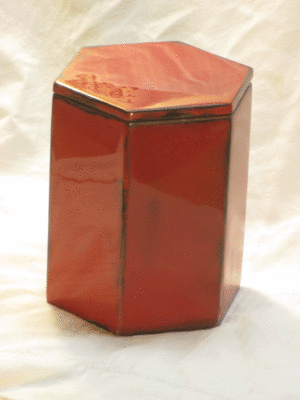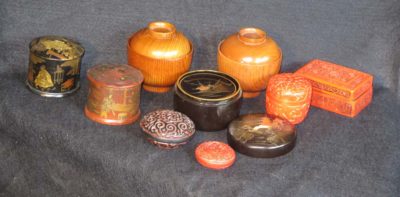Fauxrushi Inspiration
With some of my major time-gobblers finished or at least with the ends in sight — the gunsmithing partner’s workbench, the cedar siding, refinishing the dining chairs, the book manuscript (still a lot to do but at least the train is moving steadily down the tracks) — I am refocusing on a small handful of interests in the shop, including my efforts to replicate Asian lacquerwork.
I am noticing that with increasing age my general allergy sensitivity is getting worse so I am not likely to try using genuine urushi, it being the refined sap of a poison sumac tree and all. It is not impossible, but unlikely given the toxicity of the emulsion. Still the performance of the final finish is such that it has been the theoretical model of “the perfect finish” for decades or even centuries. Anything that can be applied and polished to a mirror surface while being impervious to anything other than boiling nitric acid or long term UV degradation is a finish to not disregard entirely.
My allergic sensitivity is being driven home this year as we had a late, cold, wet spring (we had snow flurries three weeks ago!) so the “early pollen” and the “late pollen” are emerging back-to-back, resulting in the Mother of All Sneezefests. I’ve been breathing through jello for almost a week now with the resultant gurgling loveliness. Rather than compounding my miseries with liquid poison ivy (the same toxic allergen, urushiol, is present in poison sumac, poison ok, poison ivy, and mango skin) I am instead going to be employing a variety of alternatives to accomplish “fauxrushi” objects.

I have already written about West System 105 Epoxy and the variations of their catalysts as the basis for my fauxrushi (Popular Woodworking April 2017) and I am currently looking at three different polyester compositions as a test comparison. Polyester is reputed to be tougher and harder than epoxy but I have never used it for anything other than laying fiberglass fabric. It does have the distinct disadvantage of being much stinkier that West Epoxy but that is not an insurmountable problem.

My little menagerie includes Asian lacquered pieces ranging from contemporary to probably 17th/18th C, and 19th C English japanned paper boxes (the two round pieces on the left).

I think this is my oldest piece, it is certainly the most complex. Red and black urushi are applied in alternating layers and then carved to reveal the layers. Urushi work is dominated historically by those two colors with the occasional blue piece with other colors even more scarce.
From time to time I pull out my own meager collection of genuine lacquerwork for inspiration and instruction, and delve into my library on the subject. These sources spur me on to explore this art form, and when the resin base, whether epoxy, polyester, or even urushi, is combined with silver, gold, ad pearl, the sublime can emerge under the eye and hand of a master. I am hampered by the near-complete absence of artistic talent but I nevertheless intend to stride down this path either until I lose interest (unlikely) or simply cannot physically do the work. My hands are still steady so I am hoping it will be a long journey.

This modern bowl has a molded fabric core, and remains one of the most beautiful artworks I have ever seen.


Join the Conversation!